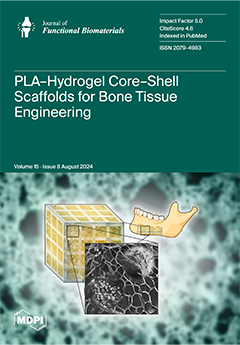Multilayer monolithic zirconia, which incorporates polychromatic layers that mimic natural tooth gradients, offers enhanced aesthetics and functionality while reducing debonding risks and improving fabrication efficiency. However, uncertainties remain regarding the fracture characteristics of multilayer monolithic zirconia crowns under occlusal loading, whether composed of
[...] Read more.
Multilayer monolithic zirconia, which incorporates polychromatic layers that mimic natural tooth gradients, offers enhanced aesthetics and functionality while reducing debonding risks and improving fabrication efficiency. However, uncertainties remain regarding the fracture characteristics of multilayer monolithic zirconia crowns under occlusal loading, whether composed of uniform or combined yttria levels. The current study investigated how variations in yttria levels and thicknesses affected the optical properties and fracture loads of multilayer monolithic zirconia. Samples of multilayer monolithic zirconia in the Vita A1 shade were used, while employing 3Y (SZ) and 4Y + 5Y (AZ) yttria levels. The optical properties, including the color difference (Δ
EWS) and translucency parameters (
TP00), were measured using a digital colorimeter. The fracture loads were analyzed using a universal testing machine, and fractured surfaces were examined under a stereomicroscope. Statistical analyses assessed the impacts of the yttria levels and sample thicknesses on the optical properties. The Δ
EWS values of SZ ranged 3.6 to 4.0, while for AZ, Δ
EWS at 0.5 mm was 3.9 and <2.6 for other thicknesses. The
TP00 values decreased with an increased thickness, with AZ generally exhibiting greater translucency than SZ. In the fracture load investigations, SZ (>1600 N) generally exceeded AZ (>1260 N), with fracture loads notably increasing with thickness, particularly for premolars (SZ > 3270 N, AZ > 2257 N). SZ predominantly exhibited partial and complete fractures, whereas AZ showed fewer non-fracture categorizations. Complete fractures began with dense, irregular cracks that extended outward to reveal smooth surfaces, while premolars subjected to higher loads exhibited concentric ripple-like structures. Partial fractures revealed radial textures indicative of areas of stress concentration. In summary, higher yttria levels were correlated with increased translucency, while variations in the fracture loads primarily stemmed from differences in the tooth position or thickness. Overall, multilayer monolithic zirconia incorporating combined yttria levels of 4Y + 5Y (AZ) offered high translucency, precise color matching, and substantial fracture resistance, rendering it highly suitable for aesthetic and functional dental applications.
Full article






